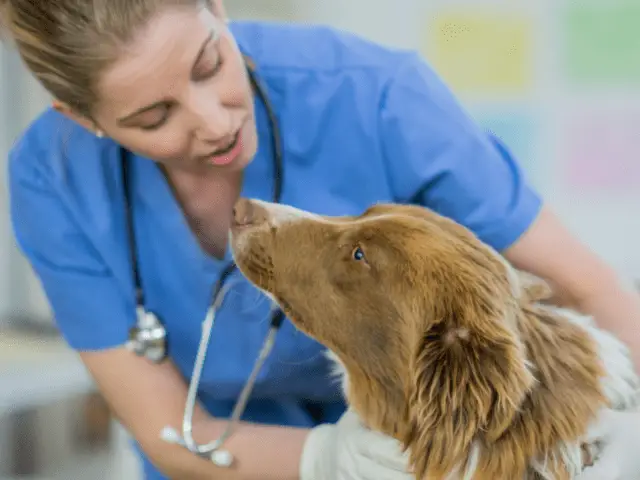Hiking is a great activity for owners to enjoy with their dogs, especially for high energy breeds that require daily physical exercise to keep them happy and healthy. While it might seem obvious that dogs would be tired after a long day of hiking, owners should be aware of abnormal signs and symptoms that may indicate extreme exhaustion or illness after a hike.
While this article can provide important information regarding what to do if your dog is exhausted after a hike, it’s always best to seek the advice of a veterinarian if you believe your pet is experiencing a medical emergency.
This article contains affiliate links. If you make a purchase through one I may receive a commission.
Things to Consider Before a Hike
Hiking can often require a great deal of planning depending on the type of hike, elevation, terrain involved, and duration of the hike. Just as hikers make plans for themselves, having a plan in place for canine companions can help avoid serious injuries or medical emergencies along the trail.
Here are some considerations dog owners should keep in mind when planning a hike with their dog.
Check the Weather

Before setting out on a hike, it’s always important to check the weather, especially during summer months or in areas with hot climates.
Owners should avoid hiking in weather with sustained temperatures of above 90°F as heightened temperatures increase the risk for developing heat stroke in dogs . Any dogs displaying symptoms of heat stroke such as excessive panting, vomiting, drooling, feeling hot to the touch, or collapse should receive immediate veterinary care.
. Any dogs displaying symptoms of heat stroke such as excessive panting, vomiting, drooling, feeling hot to the touch, or collapse should receive immediate veterinary care.
Stock Up on Supplies
When packing for a hike, dog owners should ensure they bring plenty of supplies along for themselves and also for their canine companion.
To help avoid exhaustion in dogs, hikers should ensure they are prepared with plenty of fresh drinking water, collapsible travel bowls , any necessary meals and snacks, cooling vests
, any necessary meals and snacks, cooling vests , and booties to protect paws against rough terrain or hot pavement.
, and booties to protect paws against rough terrain or hot pavement.
Safety Measures to Avoid Exhaustion

Once all the supplies for a hike have been gathered, dog owners can also take measures to avoid exhaustion while on the trail. By understanding the needs of their dog, hikers can help avoid canine medical emergencies by taking the following precautions.
Get an Early Start
To avoid over exhaustion on hot days, hikers should consider getting an early morning start when the weather is generally cooler. The early morning hours just after dawn are typically the coolest with temperatures anywhere from a few degrees up to 20°F cooler than mid-afternoon temperatures.
In addition to being a safer option for pets and their parents, an early morning hike can often be an extremely peaceful time to enjoy the birds singing and watch the sunrise.
Stay in the Shade
When considering hiking on hot days, choose easy to moderate trails that have plenty of shade along the way. Temperatures in shaded areas are generally 10-15°F cooler than in the sun and dogs with short hair or light colored coats are less susceptible to getting sunburn on delicate body parts such as the tip of the nose.
Encouraging pups to rest along the trail and offering plenty of water breaks in the shade can greatly reduce the risk for exhaustion during a hike.
Choose Water Activities
When hiking on a hot day, dogs can easily become exhausted in hot temperatures and incorporating water activities into a hike is a great way to keep pets cool and calm along the trail.
For dogs that enjoy swimming, choosing a trail with a swimming lake is a great option, but even dogs that don’t naturally take to water can benefit from a quick splash in a stream or shallow body of water to cool off during a hike.
Don’t Overdo It
When bringing canine companions along on hikes, owners should be very careful not to overdo it when it comes to the elevation, length, and terrain of the trail. Owners should be aware of signs of overexertion in dogs and never push their dog beyond their physical limits when it comes to hiking.
in dogs and never push their dog beyond their physical limits when it comes to hiking.
Have a Vet Check Up

Just like people, dogs should receive annual veterinary exams to ensure they are healthy, especially before participating in physical activities like hiking. Owners are encouraged to have an open and honest conversation with their veterinarian about hiking and follow veterinarian recommendations when it comes to hiking with their pooch.
Additionally, geriatric dogs and dogs suffering from medical conditions may not be candidates for hiking and owners should discuss options with their veterinarian before hitting the trail.
Warning Signs & Symptoms of Exhaustion
Even for owners taking every precaution when it comes to avoiding exhaustion when hiking with their dog, sometimes these things are unavoidable. In the event that a dog becomes exhausted on the trail or after a hike, owners should ensure they know the warning signs of exhaustion and what to do in the event of an emergency.
Panting: What’s Normal?
Dogs pant for a variety of reasons and panting is typically a normal behavior associated with excitement or a way to keep themselves cool during playtime of physical activity. However, there can be some very distinct differences between normal panting and panting that indicates a medical concern .
.
Although the difference in types of panting may require a trained eye, one of the best ways to distinguish a normal pant from an abnormal one is to look at the dog’s tongue and gums.
Just like humans, dogs should have a bubble gum pink tongue and gums; if a dog has red, blue, gray, or white gums in combination with abnormal panting, owners should seek immediate medical attention for their pet.
Excessive Drooling
While excessive drooling can be caused by a number of things, this behavior can indicate over exhaustion in pets on the trail.
Owners that notice excessive drooling in their pet should immediately offer water as this can be a symptom of overexertion in dogs. If hiking at high altitudes, owners should immediately decrease elevation as this can also be a symptom of altitude sickness in dogs.
in dogs.
Excessive Lethargy or Collapse

Arguably one of the most notable signs of exhaustion in dogs is severe lethargy or collapse. While it is normal for dogs to be tired after a hike and get a good night’s sleep, it is not normal for them to display symptoms of severe lethargy like loss of interest in daily activities.
Owners should keep in mind that many symptoms of exhaustion may occur well after a hike as the body continues to process and dogs displaying lethargy on the trail may deteriorate once returning home. Any owners with dogs suffering from lethargy or collapse should seek urgent veterinary care as this can often indicate a life threatening medical emergency.
Managing Exhaustion in Dogs
There are a number of intervention tactics that owners can take for dogs suffering from exhaustion after a hike, but the best option is to always seek the advice of a veterinarian for dogs displaying symptoms of overexertion.
While this may not always be possible for affected dogs while on the trail, owners should continue monitoring for symptoms once returning home and offer prompt medical care to avoid more serious injuries.
Decrease Elevation Immediately
For hikers noticing symptoms of exhaustion or altitude sickness in dogs on the trail, immediately decreasing elevation can help aid in reducing symptoms associated with high elevation. Hiking at high elevations can quickly cause dehydration and owners should ensure their pet is offered plenty of fresh water and rest.
Pack a First Aid Kit
When packing hiking supplies for dogs, owners should consider investing in a pet first aid kit . There are plenty of commercially available pet first aid kits, but at a minimum owners should ensure their kit contains bandage material, hydrogen peroxide, a muzzle, digital thermometer, and collapsible sling.
. There are plenty of commercially available pet first aid kits, but at a minimum owners should ensure their kit contains bandage material, hydrogen peroxide, a muzzle, digital thermometer, and collapsible sling.
Additionally, owners should ensure they have contact information for animal poison control , nearby emergency veterinary facilities, and any other emergency contacts.
, nearby emergency veterinary facilities, and any other emergency contacts.
Offer Plenty of Water
Dogs displaying symptoms of exhaustion during or after a hike may be suffering from dehydration and owners should ensure they offer plenty of water. Extreme thirst in dogs is a telltale sign of dehydration and owners should seek immediate veterinary care for dogs that cannot seem to quench their thirst.
Take a Canine CPR Class
Owners can be prepared in the event of a medical emergency for their dog by taking a canine CPR class. In addition to helping owners more easily identify signs and symptoms of exhaustion in their dog, participating in a canine CPR class can also prepare owners for a medical emergency.
The American Red Cross offers online pet CPR classes starting at just $25 and owners are encouraged to complete this short 35 minute course before beginning hiking with their canine companion.
starting at just $25 and owners are encouraged to complete this short 35 minute course before beginning hiking with their canine companion.
While the besy way to avoid exhaustion on a hike is by preventing it, sometimes emergencies happen and being prepared provides each dog with the best outcome in these situations. When in doubt, owners should always seek veterinary medical advice for any pets displaying abnormal behavior or signs of physical illness after hiking.

